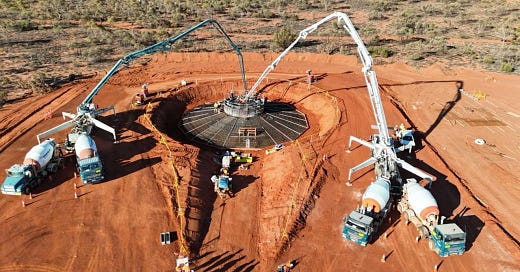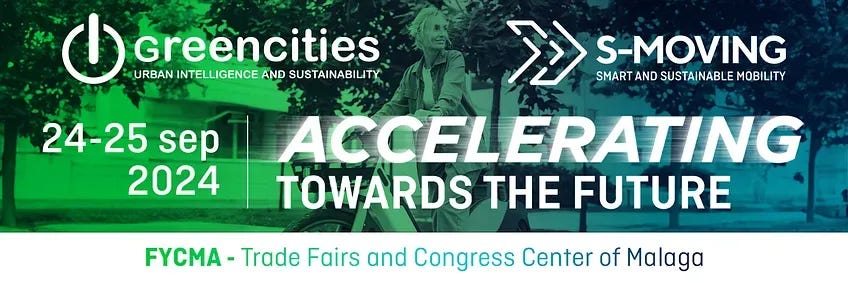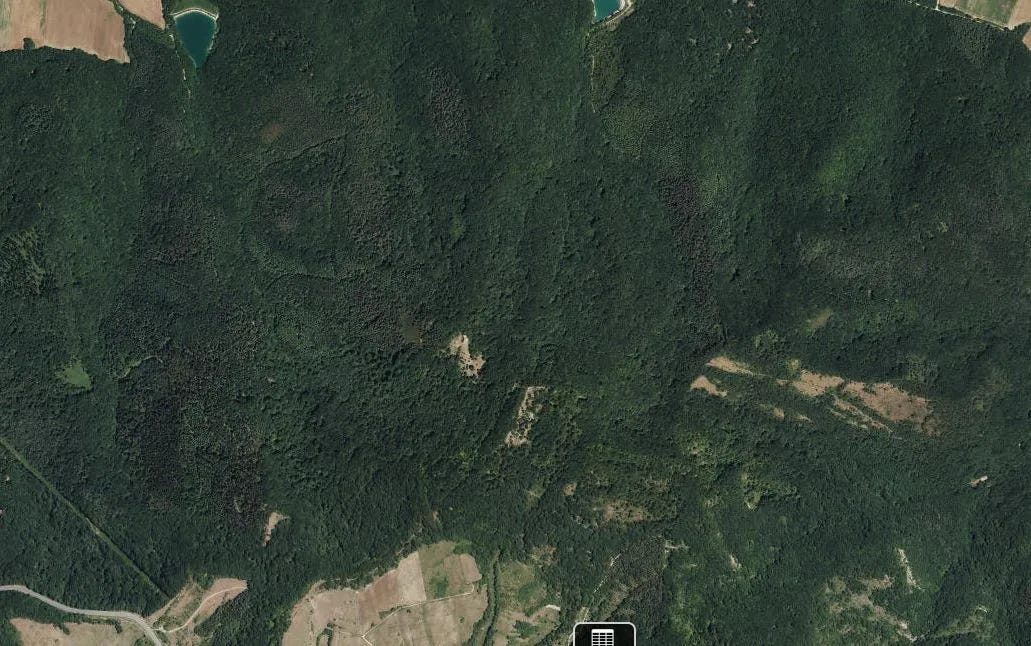Windletter #89 - One of the largest off-grid renewable systems in the world
Also: Goldwind completes a black start at a wind farm, are Chinese OEMs financeable in Europe, art and wind turbines, and more.
Hello everyone and welcome to a new issue of Windletter. I'm Sergio Fernández Munguía (@Sergio_FerMun) and here we discuss the latest news in the wind power sector from a different perspective. If you enjoy the newsletter and are not subscribed, you can do so here.
Windletter is sponsored by:
🔹 Tetrace. Specialized services in operation and maintenance, engineering, supervision, inspection, technical assistance, and distribution of spare parts in the wind sector. More information here.
🔹 RenerCycle. Development and commercialization of solutions and specialized services in the circular economy for renewable energies, including comprehensive dismantling of wind farms and waste management, refurbishment and sale of components and wind turbines, management and recycling of blades and others. More information here.
Windletter está disponible en español aquí
The most-read from the last edition were: the video of the assembly of Mingyang's OceanX, Jerry Randall's post on different wind resources, and investments in the European supply chain.
Let's dive into this week's news.
⚡ One of the largest off-grid renewable systems in the world
This week I bring you a really interesting project. It is the generation plant associated with the Tropicana gold mine, owned by AngloGold Ashanti, located in Australia.
This system is probably one of the largest off-grid renewable systems in the world, combining wind, solar generation, and a battery system, in addition to a gas power plant.
The origin of this installation dates back to 2012 with a 27.5 MW diesel plant, which was responsible for powering the mine from the start of its operation. Just 4 years later, in 2016, the diesel plant was transformed into a 54 MW gas system.
By 2023, the decision was made to switch to renewable generation, integrating into the system:
4 Goldwind GW165/6.0MW wind turbines with 6 MW, 165 meters in rotor diameter, and 135 meters in hub height.
A 24 MW photovoltaic installation with a single-axis tracker.
A 14 MW power battery system (BESS) (capacity unknown).
With this system, gas consumption is expected to be reduced by 50%, with the consequent CO2 emissions savings estimated at 65,000 tons per year.
The way the project is financed is also very interesting, with Pacific Energy building the project and operating it for 10 years under a build-own-operate format and signing a PPA with AngloGold Ashanti. After those 10 years, the ownership of the project will transfer to the mine.
In this way, the capital needed to build the project is financed through the PPA itself, always maintaining the mine’s energy cost at current levels to guarantee its competitiveness. This means that starting from year 10, the energy savings for the mine will be significant.
Pacific Energy has released a video where some details of the installation and the different technologies can be seen.
It must be really interesting to see the entire hybrid system operating together, with the controller prioritizing one energy source or another, charging and discharging the batteries, maintaining (or not maintaining) a minimum level of gas generation… surely the system’s integration and performance will improve over time as operational experience is gained.
Some of you may have been reminded of Gorona del Viento, the hydro-wind power station on the island of El Hierro, in the Canary Islands, which combines a diesel generation system with a wind farm and a reversible pumping station. A plant, by the way, that just celebrated its 10th anniversary recently.
_
Sustainable mobility and cities have a date in Málaga this September… and you're invited
On September 24 and 25, the Greencities & S-Moving event will take place in Málaga, a meeting with more than 15 years of history where you can explore how cities are evolving to become smarter and more sustainable, as well as the future of urban mobility.
At the event, experts from around the world will address upcoming urban and mobility challenges. For instance, it was recently confirmed that experts such as Mario Picazo, meteorologist and presenter, and Javier Goyeneche, founder of Ecoalf, will participate. Two prominent names in an agenda that will bring together more than 140 speakers to discuss urbanism, mobility, and sustainability.
If you are a Windletter subscriber, you can register for the event for free through this link.
_
🚢 Voltaire, the largest wind turbine installation vessel in the world
In parallel to the growth of offshore wind turbines, installation vessels have also had to grow.
This has led to significant investments in new installation vessels, such as in the case of the Belgian company Jan de Nul, which has commissioned the construction of the largest wind turbine installation vessel (jack-up vessel) in the world, the Voltaire, in China.
The Voltaire was built at the COSCO Shipping Shipyard in Nantong (China), and with a maximum height of 325 meters, it is the tallest wind turbine installation vessel in the world.
Main characteristics (link to technical sheet)
Length: 169.3 meters
Beam: 60.0 meters
Draft: 7.5 meters
Installed power: 24.8 MW
Speed: 11.5 knots
Loading capacity: 14,000 tons
The Voltaire is being used to install the Haliade X turbines at the Dogger Bank wind farm in the United Kingdom.
As always, the size of these things is best understood when compared to the Eiffel Tower.
By the way, the Spanish company Ingeteam was in charge of designing the entire electrical system and the various control systems of the vessel. More information about the vessel can be found here.
Interestingly, just as I had finished writing this news, Windpowermonthly published that a ship with the capacity to install 26 MW wind turbines has just been launched in China. We will analyze it in future Windletter editions.
_
🌍 Mingyang continues its international expansion by entering Brazil
Mingyang Smart Energy has announced its first contract in Brazil, and also the first in all of South America, thus certifying its entry into a new region and a market as competitive as the Brazilian one.
The agreement has been signed with the developer Copel, one of the largest in the country, and the supply is for the MySE 6.25-172 turbine, although the number of units and the project have not been disclosed.
Mingyang is not the first Chinese OEM to enter Brazil. Let’s remember that Goldwind has a strong presence and recently bought a former General Electric factory to start manufacturing in the country.
_
_
🔋 Goldwind completes a black start of a hybrid wind farm with batteries
Goldwind has completed its first black start at a wind farm hybridized with batteries and connected to a 220 kV grid.
This test has allowed Goldwind to validate the grid-forming technology of its wind turbines. The test was carried out at a 200 MW wind farm and 36 MW / 120 MWh of batteries.
For those less familiar, a black start is the ability to start the power grid from zero, that is, without relying on any external energy source. It’s like if a power plant could "start" on its own after a total blackout.
In this case, the wind farm can use the energy stored in the batteries to start up and begin generating electricity on its own, without needing other synchronous power plants (such as thermal or hydroelectric plants) to help it start, which is currently the method for restoring the grid in case of a blackout.
_
💶 Are Chinese wind turbines financeable in Europe?
An interesting article by Clément Weber, consultant at Green Giraffe Advisory, on whether Chinese wind turbines are financeable in the European offshore market.
The article arises from the latest news starring Mingyang:
Being chosen by Luxcara as the preferred supplier for an offshore wind farm in Germany.
The agreement between Mingyang and Renexia to open a factory in Italy to supply the turbines for the parks developed by Renexia itself.
Clément's analysis is quite thorough, reaching a rather interesting conclusion:
Western OEMs can breathe easy. Even without a protectionist policy, there won’t be a flood of Chinese OEMs in Europe anytime soon.
It’s worth reading the article on the Green Giraffe Advisory website.
_
🌊 Gazelle Wind Power to install a 2 MW prototype in Portugal
Gazelle Wind Power is a startup based in Dublin that is developing a platform for floating offshore wind power. The design of its platform is somewhat peculiar, with moving parts, and unlike anything we usually see in the industry.
Now Gazelle has announced the name of what will be its first prototype: Nau Azul, which in Portuguese means "blue ship," but also plays on the sound of the word “Nau” (Now), in English.
The 2 MW prototype will be installed in Aguçadoura. In fact, Gazelle Wind Power has opened offices in Viana do Castelo to manage everything closely.
We will be watching for future developments.
_
🍃 The importance of a good environmental impact study
Following the controversy with the Maestrazgo project, I found Mario Castellanos' post on LinkedIn very interesting.
In it, you can see a photo of a forest area where a transmission line must be laid underground from the southeast to the northwest, crossing through the entire wooded area.
Initially, the environmental impact study estimated that several hectares of beech forest would need to be felled to build the transmission line. However, the reality was quite different.
After a field visit, it was realized that underneath that forest thickness, there was a perfectly usable path to run the transmission line, reducing the impact to the removal of 5 trees and some pruning.
A clear example of the need to delve into detail from the early stages.
_
🎨 Urban art on the wind turbines of the Hedet wind farm, Finland
Browsing through LinkedIn, I came across some beautiful photos of wind turbine towers painted with urban art. After some investigation, I found that it is the Hedet wind farm in Finland, developed by Neoen, with Nordex wind turbines.
I truly believe that this type of initiative should be more common, as I think it can add value to the wind farm and even turn it into a kind of tourist attraction. What do you think?
The artist behind the works is Viv Magia, although I struggled to find good photos of the work online.
Thank you very much for reading Windletter and many thanks to Tetrace and RenerCycle, our main sponsors, for making it possible. If you liked it:
Give it a ❤️
Share it on WhatsApp with this link
And if you feel like it, recommend Windletter to help me grow 🚀
See you next time!
Disclaimer: The opinions presented in Windletter are mine and do not necessarily reflect the views of my employer.










